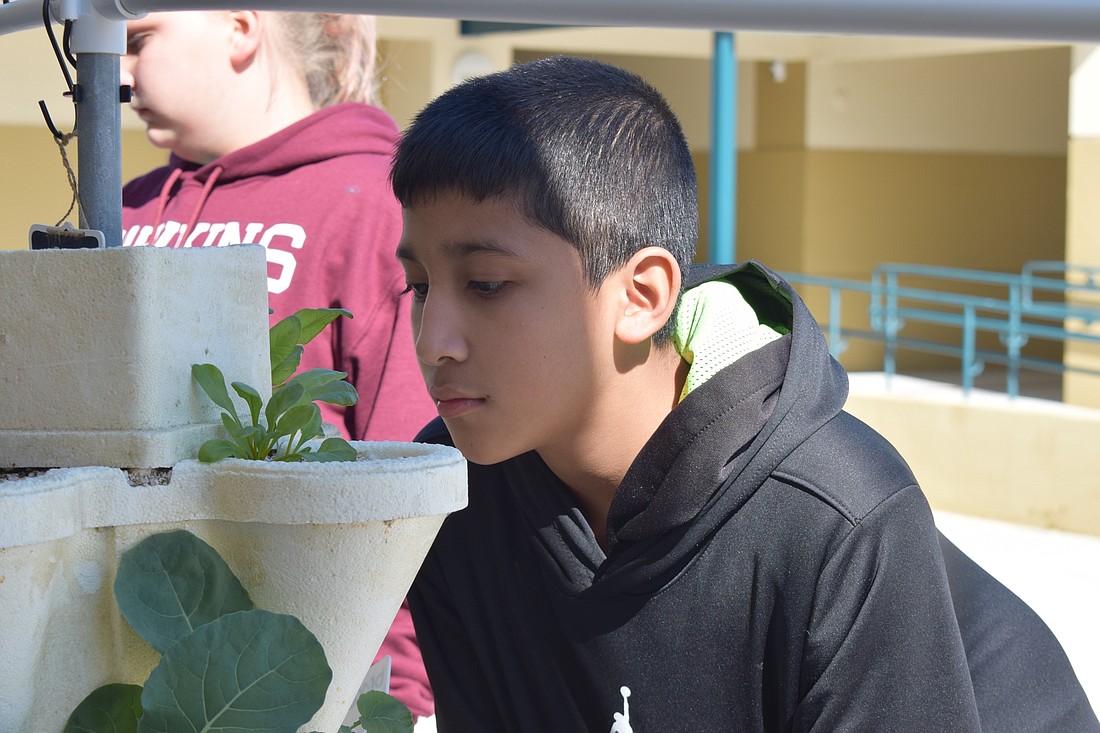- December 20, 2025
-
-
Loading

Loading

Emma Albert, a fifth grader at Myakka City Elementary School, bent down and gently inspected a small plant in a pocket of a hydroponic stacker.
Albert is one of about 24 students involved in the school’s Garden Club, which is using new hydroponic stackers to grow various vegetables and plants.
The Southwest Florida Water Management District awarded Myakka City Elementary School a $2,000 grant as part of the Splash! school grant program to enhance students’ knowledge of freshwater resources in kindergarten through 12th grade.
As a result of the grant, the school was able to move the garden from the back of the school to the courtyard for all students to see as they pass. The school was also able to expand the club because of the move.
The club started at the school last year with only third grade students. The club expanded this year to include third, fourth and fifth grade students.
Interest in the hydroponic stackers stemmed from Amanda Keeney, the school’s cafeteria manager, who has been using stackers at her home to grow various plants for her family.
“It’s such a cool concept and a different way to grow in Florida,” Keeney said. “Florida has so many difficulties growing in the soil. … With hydro stackers, I was able to be successful, and it’s a great nod to water conservation as well.”
Hydroponic stackers can hold about 20 plants and only use a quart of water three times per day.
Paraprofessional Randy True, who used to grow 15,000 plants on half an acre of land using hydroponic stackers, said the stackers are an excellent utilization of land.
In the third week of October, students spent a week planting seeds for various plants,such as pumpkins, strawberries, lettuce, beets, melons and radishes.
“My favorite part is the first time they see a fruit or a vegetable start to grow,” Keeney said. “It’s almost like Christmas morning. It is so much fun to watch them because it gives them a huge sense of accomplishment.”
Peyton Snyder, a fifth grader, said the project is going well so far, and the students will continue to turn the stackers, which are covered by some shade, so the plants can grow evenly in the sun.
“[The project] gives us a chance to learn new things and grow without pesticides,” Snyder said.
True said the project ignites a desire for the students to continue working with hydroponic stackers.
“We might be looking at future farmers,” True said. “Somebody’s got to do it.”
Keeney said it’s important for students to understand where their food comes from and to learn how to make their own food.
“Organic food is not cheap,” Keeney said. “If you can grow it in your backyard, it’s obviously much better for you. You know where it’s coming from, and it’s a lot more cost effective.”
When the plants are ready to harvest, Keeney wants to show students how to prepare the different produce and have them taste them.
Last year, the third graders used vegetables they grew to make lettuce wraps and served them to their classmates.
In the future, Keeney would like the students donate some of the fruits and vegetables they grow to the community or try to set up a small farmers market to teach students business concepts.
The club is also working with the School District of Manatee County Food and Nutrition department to have the garden be USDA-certified, so they can sell fruits and vegetables to the school’s cafeteria to incorporate into school meals.